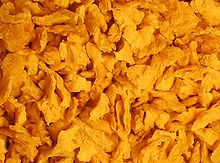Textured vegetable protein

Textured or texturized vegetable protein (TVP), also known as textured soy protein (TSP), soy meat, or soya chunks is a defatted soy flour product, a by-product of extracting soybean oil. It is often used as a meat analogue or meat extender. It is quick to cook, with a protein content comparable to certain meats.
History
Textured vegetable protein was invented by the agricultural commodities and food processing company Archer Daniels Midland in the 1960s; the company owns the TVP name as a registered trademark.[1] Archer Daniels Midland had developed a textured soy protein isolate made with an extruder in the shape of rods or tubes. The soy protein isolate was produced in a small pilot plant and sold for use in chili powder, but the product was not commercially successful. By 1968, TVP was widely used in a variety of food products, and consumption skyrocketed after 1971, when TVP was approved for use in school lunch programs. By 1980, similar products were being produced by rival companies in America, but Archer Daniels Midland remained the leader in TVP production.[2]
Manufacturing process
TVP is usually made from high (50%) soy protein, soy flour or concentrate, but can also be made from cottonseed, wheat, and oats. It is extruded into various shapes (chunks, flakes, nuggets, grains, and strips) and sizes, exiting the nozzle while still hot and expanding as it does so.[3] The defatted thermoplastic proteins are heated to 150–200 °C (300–390 °F), which denatures them into a fibrous, insoluble, porous network that can soak up as much as three times its weight in liquids. As the pressurized molten protein mixture exits the extruder, the sudden drop in pressure causes rapid expansion into a puffy solid that is then dried. As much as 50% protein when dry, TVP can be rehydrated at a 2:1 ratio, which drops the percentage of protein to an approximation of ground meat at 16%. TVP is primarily used as a meat substitute due to its very low cost at less than a third the price of ground beef [4][5] and, when cooked together, will help retain more nutrients from the meat by absorbing juices normally lost.[4]
많은 TVP 생산자들은 콩 단백질로부터 콩 지방을 분리하기 위해 헥산을 사용하며, 제조 후 소량의 용제가 남아 있다. 그러나 몇몇 설치류 연구는 TVP로부터 충분한 헥산인을 얻어서 해를 끼치기는 거의 불가능할 것이라는 것을 시사한다.[6] TVP에서 측정된 잔류 헥산 수치는 약 20ppm이다.[7] 설치류에 대한 연구는 5g/kg이 바람직하지 않은 영향을 관찰할 수 있는 최소 선량임을 보여준다.
특성.
| 100g당 영양가(3.5온스) | |
|---|---|
| 에너지 | 1,392 kJ(333 kcal) |
33.9 g | |
| 설탕 | 16.4 g |
| 식이섬유 | 17.5g |
1.2 g | |
51.5 g | |
| 비타민 | 수량 %DV† |
| 티아민(B1) | 61% 0.7mg |
| 리보플라빈(B2) | 21% 0.253mg |
| 나이아신 (B3) | 17% 2.612mg |
| 비타민 B6 | 44% 0.574mg |
| 엽산(B9) | 76% 305 μg |
| 비타민 C | 0% 0mg |
| 광물 | 수량 %DV† |
| 칼슘 | 24% 241mg |
| 철 | 71% 9.2mg |
| 마그네슘 | 82% 290mg |
| 인 | 96% 674 mg |
| 칼륨 | 51% 2384 mg |
| 셀레늄 | 2% 1.7 μg |
| 나트륨 | 1% 20mg |
| 아연 | 26% 2.5mg |
| 기타 성분 | 수량 |
| 물 | 7.25g |
| †성인을 위한 미국의 권장사항을 사용하여 대략적으로 백분율을 추정한다. | |
TVP는 콩가루나 농축액으로 만들 수 있으며, 각각 50%와 70%의 콩 단백질을 함유하고 있다. 그들은 순한 콩 맛을 가지고 있다. 둘 다 사용하기 전에 수분이 필요하며, 같은 단계에서 맛을 더하는 경우도 있다. TVP는 압출되어 콩 단백질의 구조에 변화를 일으켜 섬유질, 해면질 기질이 육류와 유사하게 된다. 탈수형 TVP는 유통기한이 1년 이상이지만 수분이 공급되면 며칠 안에 상한다. 얇게 벗겨진 형태로, 그것은 갈은 고기와 비슷하게 사용될 수 있다.
영양
건조 질감 식물성 단백질은 물 7%, 단백질 52%, 탄수화물 34%, 지방 1%(표)이다.[8] A에 100-gram (3+1⁄2-ounce) reference amount, it provides 1,370 kilojoules (327 kilocalories) of food energy, and is a rich source (20% or more of the Daily Value, DV) of several B vitamins, including folate (76% DV), and dietary minerals, especially phosphorus, magnesium, and iron (71-96% DV).
Uses
This section possibly contains original research. (July 2015) |
Textured vegetable protein is a versatile substance; different forms allow it to take on the texture of whatever ground meat it is substituting.[9] Using TVP, one can make vegetarian or vegan versions of traditionally meat-based dishes, such as chili con carne, spaghetti bolognese, sloppy joes, tacos, burgers, or burritos.
Soy[10] protein can also be used as a low cost and high nutrition extender in comminuted meat and poultry products, and in tuna salads.[11][12] Food service, retail and institutional (primarily school lunch and correctional) facilities regularly use such "extended" products. Extension may result in diminished flavor, although extra seasoning can suffice, but fat and cholesterol levels are decreased. TVP being used by itself as a substitute has no fat at all,[13] and can be effectively seasoned to taste like red meat[citation needed].
Textured vegetable protein can be found in health food stores and larger supermarkets, usually in the bulk section. TVP is also very lightweight and is often used in backpacking recipes. Because of its relatively low cost, high protein content, and long shelf life,[14] TVP is often used in prisons and schools, as well as for disaster preparedness. Those with certain allergies, however, should avoid TVP.
See also
References
- ^ Decker, Fred. "Textured Vegetable Protein (TVP) vs. Textured Soy Protein (TSP)". NationalGeographic.com. p. 1. Archived from the original on May 27, 2013. Retrieved May 20, 2013.
- ^ Shurtleff, William; Aoyagi, Akiko. "Archer Daniels Midland Company". Soy Info Center. p. 1. Retrieved May 19, 2013.
- ^ Foote R (1996). Food preparation and cooking. Cheltenham: Stanley Thornes. pp. 393. ISBN 0-7487-2566-0.
- ^ a b Clark JD, Valentas KJ, Levine L (1991). Food processing operations and scale-up. New York: CRC Press. pp. 134–7. ISBN 0-8247-8279-8.
- ^ Riaz MN (2006). Soy applications in food. Boca Raton: CRC Press. pp. 155–84. ISBN 0-8493-2981-7.
- ^ Brian Palmer (2010-04-26). "Is Your Veggie Burger Killing You?". Slate. Retrieved 2012-03-23.
- ^ "Behind the Bean The Heroes and Charlatans of the Natural and Organic Soy Foods Industry" (PDF). Cornucopia Institute. 2009-05-18. Retrieved 2019-03-12.
- ^ TVP; web page; "How Stuff Works" online; accessed ???>
- ^ T.V.P.; Your Daily Vegan;
- ^ 소이의 모든 것; 로겔 암 센터 – 지원;
- ^ Hoogenkamp, Henk W. (2005). Soy protein and formulated meat products. Wallingford, Oxon, UK: CABI Pub. ISBN 0-85199-864-X.
- ^ Joseph G. Endres (2001). Soy Protein Products. AOCS Publishing. ISBN 1-893997-27-8.
- ^ "How Many Calories in TVP". Calorie King. 2018 CalorieKing Wellness Solutions, Inc. Retrieved 2018-01-22.
- ^ 질감 식물성 단백질에 대한 모든 정보; 미국 비상 공급 웹 페이지
추가 읽기
- Shurtleff, William; Aoyagi, Akiko (2013). History of Soy Flour, Grits and Flakes (510 CE to 2013): Extensively Annotated Bibliography and Sourcebook (illustrated ed.). Soyinfo Center. ISBN 978-1928914631. Retrieved 24 April 2014.




